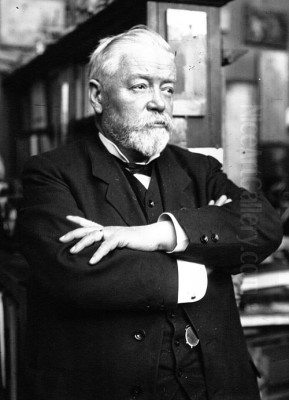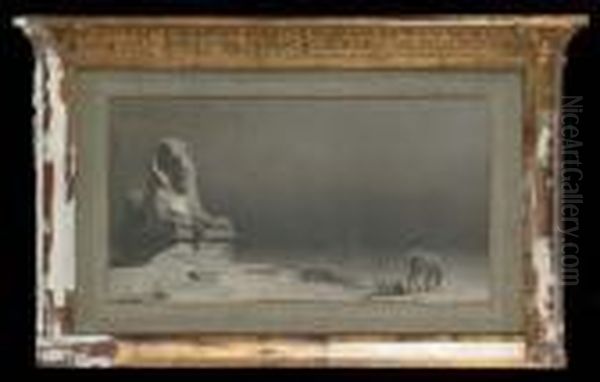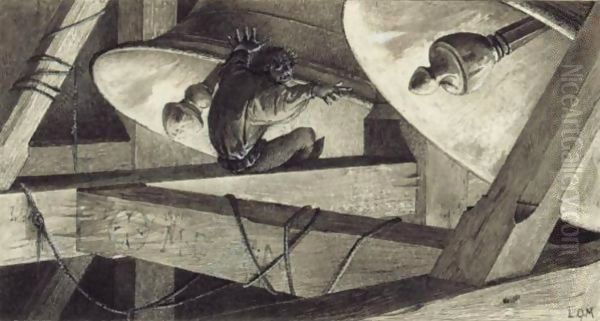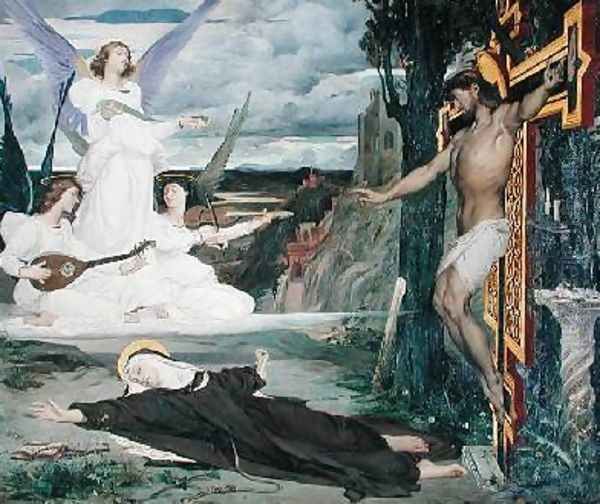
Luc-Olivier Merson stands as a significant, if sometimes overlooked, figure in late 19th and early 20th-century French art. A product of the rigorous academic tradition, Merson distinguished himself not only as a painter of historical and religious subjects but also as an influential designer of decorative arts, stained glass, mosaics, and, most notably, postage stamps and currency. His career bridged the gap between the established Salon system and the burgeoning modern art movements, leaving a legacy characterized by technical skill, imaginative compositions, and a distinctive blend of Romanticism and Symbolism.
Early Life and Artistic Formation
Nicolas Luc-Olivier Merson was born in Paris, France, on May 21, 1846, into an environment steeped in art and culture. His father, Charles-Olivier Merson, was a respected painter and art critic, whose influence undoubtedly shaped young Luc-Olivier's early artistic inclinations. Growing up in such a household provided him with an invaluable introduction to the art world, its practices, and its intellectual currents. This familial background fostered a deep appreciation for the arts and laid the groundwork for his future career.
Merson's formal artistic education began at the École de Dessin, a preparatory school that emphasized foundational drawing skills. He later progressed to the prestigious École des Beaux-Arts in Paris, the bastion of academic art training in France. There, he honed his talents under the tutelage of notable masters. Among his instructors were Gustave Chassevent, known for his historical and genre paintings, and Isidore Pils, a celebrated painter of military scenes and religious subjects, who himself had won the coveted Prix de Rome in 1838. Pils, in particular, would have instilled in Merson a respect for grand compositions and historical accuracy. Later, Merson also studied with Clément Serveau, further refining his academic technique. This rigorous training equipped Merson with a mastery of draughtsmanship, composition, and the classical ideals that were paramount in the academic tradition.
The Prix de Rome and Italian Sojourn

A pivotal moment in Merson's early career came in 1869 when he was awarded the prestigious Prix de Rome for painting. This highly coveted prize, granted by the Académie des Beaux-Arts, was the ultimate recognition for young French artists, offering them a funded residency at the French Academy in Rome, housed in the Villa Medici. Merson won this honor for his painting Le Soldat de Marathon (The Soldier of Marathon), a work that demonstrated his command of the human form and his ability to convey dramatic historical narratives, themes highly favored by the Academy.
The years Merson spent in Italy, typically a period of three to five years for laureates, were profoundly influential. Immersion in the artistic heritage of Rome and other Italian cities exposed him directly to the masterpieces of the Renaissance and Baroque periods. He would have studied the works of giants like Raphael, Michelangelo, Leonardo da Vinci, Titian, and Caravaggio, absorbing their approaches to composition, color, light, and anatomical representation. The frescoes and grand altarpieces he encountered in Italy undoubtedly informed his later work, particularly his religious paintings and large-scale decorative commissions. This period was crucial for developing his personal style, allowing him to synthesize classical influences with his own burgeoning artistic vision.
Rise to Prominence and Academic Success
Upon his return to France from Italy, Merson quickly established himself as a prominent artist. His success at the Prix de Rome had already marked him as a talent to watch, and he began to exhibit regularly at the Paris Salon, the official art exhibition of the Académie des Beaux-Arts and the most important venue for artists to gain recognition and patronage. In 1875, his reputation was further solidified when he won a first-class medal at the Salon organized by the Société des Artistes Français for his work, signaling his arrival as a significant figure in the French art establishment.
Merson's career continued to flourish within the academic system. He received numerous accolades, including a gold medal at the Exposition Universelle (World's Fair) in Paris in 1889, an event that showcased French artistic and industrial prowess to the world. His achievements were formally recognized by his peers when, in 1892, he was elected as a member of the prestigious Académie des Beaux-Arts, one of the five academies of the Institut de France. This was a significant honor, placing him among the elite of the French art world. Later in his career, his contributions to French art and culture were acknowledged with the Legion of Honour, initially as a Chevalier (Knight) and eventually being promoted to the rank of Officier, a testament to his esteemed position.
Artistic Style and Influences

Luc-Olivier Merson's artistic style is primarily rooted in the French Academic tradition, which emphasized meticulous draughtsmanship, idealized forms, and grand historical or mythological themes. However, his work also reveals strong influences from Romanticism and, increasingly, Symbolism, lending it a unique character. His early training under figures like Isidore Pils grounded him in the principles of historical painting, focusing on narrative clarity and dramatic effect.
The time spent in Italy exposed Merson to the masters of the High Renaissance, particularly Raphael, whose harmony of composition and grace of figures left a lasting impression. The influence of Renaissance frescoes can be seen in Merson's approach to large-scale decorative works. As his career progressed, his style evolved to incorporate elements of Symbolism. This is evident in his use of mystical light, dreamlike atmospheres, and evocative, often enigmatic, subject matter. His paintings frequently possess a poetic quality, moving beyond straightforward narrative to explore deeper emotional or spiritual states. Merson was known for his fine, detailed brushwork and a sensitive use of color, often employing a rich, sometimes somber, palette to enhance the mood of his compositions. He masterfully handled light and shadow (chiaroscuro) to create dramatic and often mysterious effects, particularly in his religious and mythological scenes.
Major Paintings and Thematic Concerns
Merson's oeuvre is rich with significant paintings, primarily focusing on religious and historical subjects, which were highly valued within the academic tradition. His Prix de Rome-winning painting, Le Soldat de Marathon (1869), depicted the legendary Greek soldier Pheidippides announcing the victory at Marathon, a subject that allowed for heroic nudity and dramatic pathos, hallmarks of academic history painting.
Perhaps his most famous and widely reproduced painting is Repos pendant la fuite en Égypte (Rest on the Flight into Egypt), painted in 1880. This work is remarkable for its unique and imaginative interpretation of a traditional religious theme. Instead of a conventional landscape, Merson places the Holy Family resting between the paws of a colossal, ancient Egyptian sphinx under a star-studded desert sky. The Virgin Mary and Child Jesus sleep peacefully, protected by the silent, enigmatic monument, while Joseph keeps watch. The painting combines meticulous realism in the figures with a profound sense of mystery and timelessness, characteristic of Symbolist tendencies. The juxtaposition of Christian figures with a pagan monument creates a powerful and thought-provoking image. An earlier version, La Fuite en Egypte (1879), also explored this theme with similar sensitivity.

Another iconic work is Notre-Dame de Paris (1881). This painting, clearly inspired by Victor Hugo's famous novel of the same name, depicts a haunting, nocturnal view of the cathedral. A gargoyle, a quintessential Gothic motif, looms in the foreground, gazing out over the dimly lit city. The work captures the mysterious and romantic atmosphere associated with the medieval cathedral and aligns with the Symbolist fascination with the mystical and the sublime. It became an incredibly popular image, widely disseminated through reproductions.
Throughout his career, Merson consistently returned to religious themes, often imbuing them with a personal and introspective quality. His works frequently explored moments of divine intervention, spiritual contemplation, or biblical narratives, rendered with technical finesse and a deep sense of reverence, yet often with an unconventional, imaginative twist.
Decorative Commissions and Public Art
Beyond his easel paintings, Luc-Olivier Merson was highly sought after for large-scale decorative commissions, a field where his academic training and compositional skills were particularly well-suited. He created significant works for important public and private buildings, contributing to the rich tradition of decorative arts in France during the late 19th and early 20th centuries.
Merson was commissioned to produce mosaics for the iconic Sacré-Cœur Basilica in Montmartre, Paris, one of the city's most recognizable landmarks. His designs for this monumental project would have required careful consideration of scale, visibility, and the interplay of colored tesserae. He also undertook decorative work for the Palais de Justice (Law Courts) in Paris and the Musée Pasteur, dedicated to the life and work of the renowned scientist Louis Pasteur. These commissions often involved allegorical or historical scenes appropriate to the function of the buildings.
His talents extended to the art of stained glass. He designed windows for several churches, including notable examples for the Holy Trinity Rittenhouse Square Church in Philadelphia, Pennsylvania, demonstrating his international reach. In France, he collaborated with the master glassmaker Eugène Stanislas Oudinot on windows for the church of Saint-Sylvain in Levroux, with works such as L'Adoration des Mages (The Adoration of the Magi) and Le Mariage de Saint Sylvain et Valériane (The Marriage of Saint Sylvain and Valeriana). These stained glass designs would have showcased his ability to work with light and color in a different medium, creating luminous and spiritually uplifting imagery. These large-scale projects underscore Merson's versatility and his significant contribution to the public art of his time.
A Pioneer in Philatelic and Numismatic Design
One of Luc-Olivier Merson's most enduring legacies lies in his innovative work as a designer of postage stamps and currency. In an era when such items were becoming increasingly important symbols of national identity and artistic expression, Merson brought his considerable artistic skill to this specialized field.
He is particularly famous for the "Type Merson" series of stamps, first issued for French postage in 1900. These stamps were revolutionary for several reasons: they were among the first bi-color definitive stamps issued by France, requiring a sophisticated printing process; they were larger in format than previous definitive stamps, allowing for a more detailed and impactful design; and some denominations from this series became France's first airmail stamps. The central design typically featured an allegorical figure of the French Republic, often flanked by symbols of peace, liberty, or commerce, such as "La France assise, casquée et drapée à l'antique, protégeant la Paix et le Travail" (France seated, helmeted and draped in classical style, protecting Peace and Labor). These designs were elegant, classically inspired, and projected an image of a strong, peaceful, and industrious nation.
The Merson-type stamps were highly successful and remained in use for several decades, undergoing various modifications and printings. He also designed stamps for other territories, including Monaco, further cementing his reputation in philatelic circles. Beyond stamps, Merson contributed designs for French banknotes, such as the 100 Franc note (1910-1938), showcasing his ability to adapt his artistic style to the specific requirements of currency design, which demanded clarity, security features, and symbolic resonance. His work in this domain made high-quality artistic design accessible to the general public on a daily basis and remains highly prized by collectors today.
Teaching and Influence on Students
Like many established academicians of his time, Luc-Olivier Merson also dedicated part of his career to teaching, passing on his knowledge and skills to a new generation of artists. He held a professorship at the École des Beaux-Arts, the very institution where he had received his own formative training. His position there allowed him to influence students who would go on to pursue diverse artistic paths.
Among his notable students were artists from various backgrounds. Claire Shuttleworth, an American painter, studied under Merson in Paris, absorbing his academic techniques before returning to the United States. Martha Cunz, a Swiss artist, particularly known for her color woodcuts, also benefited from Merson's instruction. While the academic style Merson championed was increasingly challenged by avant-garde movements, his emphasis on strong draughtsmanship, compositional rigor, and technical proficiency provided a solid foundation for his students, regardless of the specific direction their art eventually took. His role as an educator contributed to the continuity of artistic traditions, even as the art world was undergoing profound transformations.
Contemporaries and the Artistic Milieu
Luc-Olivier Merson's career unfolded during a dynamic and transformative period in French art. He was a contemporary of many renowned artists, and his work existed within a complex ecosystem of established academic figures, emerging Impressionists, and later, Post-Impressionists and Symbolists.
Within the academic sphere, Merson's peers and sometimes competitors included prominent figures like Jean-Léon Gérôme, known for his meticulously detailed Orientalist and historical scenes, and William-Adolphe Bouguereau, celebrated for his idealized mythological and genre paintings. Alexandre Cabanel and Ernest Meissonier were other leading academicians who dominated the Salons and official commissions. Merson's work, while adhering to academic principles, often displayed a greater poetic sensibility and a leaning towards Symbolism compared to the more straightforward classicism or historical realism of some of his contemporaries.
The rise of Impressionism, spearheaded by artists such as Claude Monet, Edgar Degas, and Pierre-Auguste Renoir, presented a radical challenge to the academic establishment. While Merson remained largely within the academic fold, the broader artistic climate was undeniably shifting. The Symbolist movement, which gained traction in the late 19th century with artists like Gustave Moreau, Odilon Redon, and Pierre Puvis de Chavannes, resonated more closely with certain aspects of Merson's art, particularly his interest in mysticism, dreamlike imagery, and subjective emotional expression. His collaborations, such as with Eugène Stanislas Oudinot in stained glass and Victor Prouvé in decorative projects and potentially stamp design discussions, also highlight the interconnectedness of artists working across different media. Merson navigated this evolving landscape, maintaining his own distinct artistic voice while contributing to various facets of French visual culture.
Later Career and Legacy
In his later career, Luc-Olivier Merson continued to be a respected figure, receiving honors and commissions. He maintained his professorship at the École des Beaux-Arts and saw his designs for stamps and currency become ubiquitous in French daily life. The Legion of Honour, culminating in the rank of Officier, underscored his esteemed status. However, the art world was rapidly changing. The avant-garde movements, from Impressionism and Post-Impressionism to Fauvism and Cubism, increasingly captured public and critical attention, gradually eclipsing the popularity of academic art.
While the grand historical and religious paintings in the academic style became less fashionable in the early 20th century, Merson's contributions, particularly in the realm of design, retained their significance. His philatelic and numismatic work, in particular, ensured his art reached a vast audience and left an indelible mark on French visual culture. Luc-Olivier Merson passed away in Paris on November 13, 1920.
Today, Merson is remembered as a highly skilled and versatile artist who excelled in multiple domains. While his large-scale paintings may be less known to the general public than those of some of his Impressionist contemporaries, works like Rest on the Flight into Egypt and Notre-Dame de Paris continue to be admired for their unique vision and technical mastery. His innovative stamp designs are celebrated by philatelists worldwide, and his decorative works contribute to the artistic heritage of the buildings they adorn. Merson represents an important bridge figure, an artist who upheld the traditions of academic art while also imbuing his work with a personal, often mystical, sensibility that resonated with the burgeoning Symbolist movement.
Conclusion
Luc-Olivier Merson was a quintessential artist of his time, a master of the academic tradition who successfully navigated the changing artistic landscape of late 19th and early 20th-century France. From his early success with the Prix de Rome to his influential role as a professor and his celebrated designs for public art, stamps, and currency, Merson demonstrated remarkable versatility and technical brilliance. His paintings, characterized by meticulous execution, imaginative compositions, and a blend of historical narrative with Symbolist undertones, hold a distinct place in French art history. While the grand manner of academic painting waned in popularity, Merson's legacy endures through his iconic philatelic designs and his contributions to the decorative arts, ensuring his continued recognition as a significant and multifaceted French artist.